ex parte NPRM Finally Published in Federal Register
Yesterday, more than a month after it was adopted by the Commission, the ex parte reform NPRM was finally published in the Federal Register. This has the effect of determining the comment period since it is always relative to FR publication:
![]()
This late publication raises two questions in view of the Commission’s stated interest in transparency:
1. Why did this important NPRM take so long to be published? Sometimes delays are due to unusual formatting problems such as tables, but that was not the case here.
2. Why doesn’t the Commission give a simple table with the actual due date of comments? OET used to publish such a table for its proceedings. Why does the public have to keep searching the for FR publication dates?
The key information on the comment dates is reprinted here for your convenience:
DATES:
Comments must be submitted by May 10, 2010, and reply comments must be submitted by June 8, 2010.(Actually, as I read §1.4, the reply comment date should be June 9. But let’s not quibble here.)
UPDATE
MSS has set a good example and has filed its comments in this proceeding early. They are the first comments filed in this proceedings, aside from another document that appears to be misfiled.
The comments include some of the MSS correspondence with FCC/OGC on a series of complaints it has made against the entity that appears to be the worst offender of the ex parte rules. For the first time these documents can now be reviewed on the FCC website. Parties filing comments may wish to consider whether a transparent ex parte system should hide the very existence of such correspondence and indicate their viewpoint in their comments.
They might also want to comment on the following sentence of the NPRM in para. 32 that seems the strangest part of the proposal: “We also seek comment on whether all ex parte sanctions, including admonitions, should be publicly announced.” The NPRM gives no hint on why such secrecy would be in the pubic interest.
(We note that the MSS ex parte complaint petition has been on circulation since 2/25/10. Oddly, the oldest item on circulation is the Petition for Determination of Effective Competition of Marcus Cable Associates, LLC which has been on circulation since 08/14/2007. Does the name “Marcus” cause delay on the 8th floor? In any case, there is no relationship at all between MSS and Marcus Cable Associates, LLC .)
FURTHER UPDATE
As of 4/28/10 the Marcus Cable Associates, LLC item is no longer on circulation. Thus it was resolved after 2.5 years of circulation. Will the MSS issue take that long?
New Spectrum Tools Available
The private effort is Unwanted Emissions, a website developed by a federal government spectrum manager who is active in IRAC matters. However, this is a personal effort that was done with the approval of his agency as it only contains public information. (“Unwanted emissions” is an inside IRAC joke for referring to FCC-authorized systems.)
The UE site has allocation table information and includes both ITU and domestic footnotes (US, G, and NG ) for the spectrum from to 9 kHz to 1000 GHz. There is even a useful guide to allocation information.


Amusingly it has this one scathing review on the Apple app site from a ham, “If there was a lower rating than 1 star. i would want as low as I could. I been a ham radio op. for 40+ years this is the most useless app I’ve seen.” Well, for most hams it is probably pretty useless, but I suspect readers of this blog will have a different viewpoint.
Both UE and Allocations allow easy access to all footnotes - not so convenient in paper versions.
From FCC NBP team we get Spectrum Dashboard which has both allocation and licensing information - at least for some bands. It also gives your lines to FCC rule parts - unfortunately it gives you the GPO site for the appropriate part of the FCC Rules, e.g. Part 90. Where that band is in the Part 90 rules in up to you to find - it can be tough in many cases. It also only deals with 225-3700 MHz while UE covers the entire allocation table to 1000 GHz. Now for most commercial systems, 225-3700 is of primary interest and this is still the beta version, so let’s not be too harsh.
You can search for a spectrum block and get something that looks like the NTIA spectrum chart for that block that tell you what services are allocated. But the information is presented in allocation jargon such as “This band is used for the Mobile Satellite Service. This is allocated for both Federal and Non-Federal use” with no indication of what the use is called in normal jargon of if the band is actually in practical use. However, you can search more in a window alongside the NTIA-like chart and find what bands in a specific service are in the frequency range of interest and then you get a plain language description of what is happening such as:
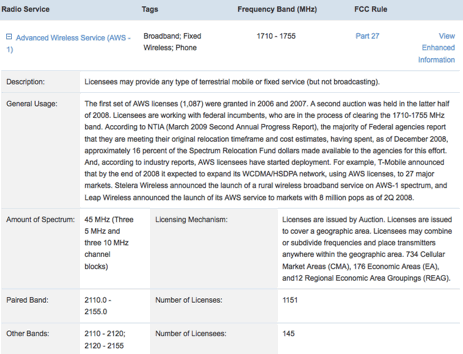
The “View Enhanced Information” button then gets you a list of licenses in that band! This was available before in ULS, but this method is much easier. You can even get maps showing the amount of spectrum available in various counties.
A downside of the Dashboard is the focus on present allocations and the lack of any information on transitions in progress and pending actions. For example a search on 2120-2180 MHz gives the following information:
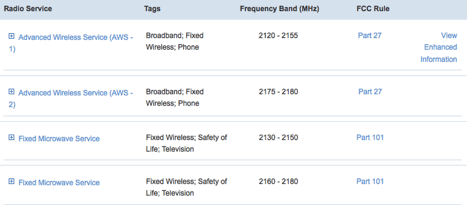
Want to buy a 2130-2150 Fixed license cheap? There is no hint at all about the AWS-3 band (2155-2175/80 MHz). No sign that the days of Fixed in this band are limited. No mention of the pending NPRM in Docket 07-195, let alone the NBP plans for this band.
In Spectrum Policy Task Force days we were trying to develop a web page with information about ongoing proceedings and WRC actions included with current allocations. Unfortunately, the resources were not available at that time. Hopefully the next version of the Dashboard will consider making this information available also.
Both websites are useful tools for the spectrum community and both need user feedback to help them evolve in the directions that users need. Feel free to post to this blog your comments to guide them and congratulations to the developers of both!
FCC is Hiring Engineers!
The log jam is finally broken and FCC has finally started hiring engineers again! Although in the FCC’s own myopic way they continue to do the minimally required advertising so no one on the outside knows about the vacancies.
Also at this late point in the academic year, FCC has done no recruiting of graduating seniors in engineering. Thus FCC appears to be missing an opportunity to hire entry level engineers for its career staff. But this is a perennial problem at FCC since they can’t even think about recruiting until every “t” is is crossed on the final budget for the year. Other agencies start recruiting in the beginning of the academic year and adjust the hiring numbers according to their budget later.
But since FCC won’t advertise these jobs, I thought I would help by posting the basic information and ask readers to share it with possible interested parties. I would love to just give a link to each job shown about, but the bizarre FCC website doesn’t permit that. So here is the basic information:
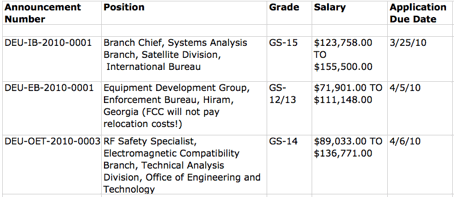
(Note that in a classic FCC personnel screwup, the third position is identified on the FCC website as shown at the top of this posting as for an “RF Specialist”. A review of the text of the job description shows that it is actually for a specialist in RF safety. This is corrected in the 2nd table which your blogger prepared.)
For more details go HERE.
Parade's Gift to CTIA Wireless 2010
As the moguls of the cell industry gather in Las Vegas for CTIA’s Wireless 2010 conference, Parade magazine, the Sunday insert in many newspapers and the most widely read magazine in the U.S., with a claimed circulation of 33 million and a readership of 73 million has the featured story shown above.
I do not believe that the Parade article reasonably discusses the present situation on safety of cell phones.
But the cellular industry brought this PR disaster on themselves by being in a severe state of denial on this issue and the public’s rightful interest in it. The cellular industry strongly fought Chmn. Kennard’s plan to make SAR data readily available on the FCC website. They did not want the public to have access to which phones have lower SARs.
I have previously contrasted policies of CTIA with its French counterpart, AFOM.
AFOM makes reasonable suggestion on how you can decrease your exposure to RF, why can’t US industry do the same?
Actually RF exposures are probably decreasing in general as operators build out their networks and decrease the average distance to cell towers from users. Broadband uplinks from users could increase exposures, but in reality mobile broadband use is generally asymmetrical with little uplink traffic.
However, the industry’s bold attempt in Docket 10-4 to kill off the cellular amplifier industry because a few poorly designed models cause interference (rather than adopting standards to prevent such designs) will increase exposures in fringe areas.
Kudos to AT&T for Its New Environmentally Friendly Charger
It’s the eco-friendly charging solution for your mobile phone. Conventional chargers left plugged in – even when not actively charging – can draw as much as 5 to 20 times more energy than stored in the battery. The advanced, energy-saving AT&T ZERO Charger outperforms other chargers by automatically shutting down when not in use. “Vampire draw” is 100% eliminated and you’ll never have to unplug your charger again! Plus, USB compatibility makes the AT&T ZERO Charger a convenient charging station for many mobile devices!
CNET News praised this development saying
The AT&T Zero Charger automatically senses when a mobile phone is not plugged up to the charger and it cuts the power supply from the wall socket. Other devices, including TVs, computers, and all kinds of home appliances, also draw power from the power grid when they are plugged in even if they aren't turned on. The U.S. Department of Energy estimates that standby power makes up as much as 20 percent of home energy use in the U.S.
The amount of power that is consumed by individual phone chargers plugged into the wall is small. But when you add it up over a long period of time, it can be significant. For example, AT&T estimates that if 80 percent of the wireless subscribers left their cell phone chargers plugged into a wall for a year, their phones would draw enough electricity to power 24,000 homes for a year, or brew 3 to 4 million cups of coffee each day.
So our congratulations to AT&T for being so environmentally conscious! (Note that your blogger’s website is carbon neutral.)
NBP - Spectrum Issues
First, at the risk of saying the obvious, we now have a rather detailed statement of strategy for spectrum - something the FCC has not had for a long time. I have previously written how other countries such as Japan and UK had such strategies and how the public availability of such information improves transparency and stimulates R&D. So whether the plan is perfect, good, or even bad, just knowing about current thinking is a great improvement over the past.
On the eve of the report’s release, the New York Times commented how the previous commission was obsessed with broadcast indecency while the current one is focusing on broadband issues. There is some truth to this. But this also points out a fundamental management problem in the FCC structure: the FCC focuses “from crisis to crisis” and the many parts of the FCC can not function in parallel while the 8th Floor is distracted by one megaproblem. Thus when the crisis of the day was indecency then spectrum policy was given little attention and now when the crisis is broadband - admittedly a broad topic - other issues get scant attention. I think FCC should look at how the UK’s Ofcom is organized and observe how this problem is not as severe in their arrangement where the board at the top acts like a corporate board overseeing top managers, not like a group of micromanagers afraid to delegate authority and who fundamentally limit overall productivity of the agency.
To me, the most exciting part of the plan was the public safety issue:
Create a Nationwide Interoperable Public Safety Wireless Broadband Communications Network.
Broadband technologies will give first responders new tools to save American lives. The nation needs a nationwide public safety broadband wireless network that allows first responders nationwide to communicate with one another at all times and without delay. A three-pronged approach will allow the speedy deployment, operation, and continued evolution of such a network. The three prongs are:
1. An administrative system to ensure that public safety users of broadband spectrum have the capacity and service they require for their network; they also should be able to leverage commercial technologies to take advantage of the vast number of applications and devices that are being developed for commercial wireless broadband networks.
2. An emergency response interoperability center to ensure that first responders nationwide can communicate with one another via public safety wireless broadband communications.
3. A grant program to help fund the construction, operation and evolution of the public safety broadband network to ensure resiliency and ubiquitous coverage.

Another great recommendation is
RECOMMENDATION 5.6:
Congress should consider granting authority to the FCC to impose spectrum fees on license holders and to NTIA to impose spectrum fees on users of government spectrum.
One interesting point is that this addresses Federal Government spectrum at all! In the draft Spectrum Policy Task Force report there was one point that just suggested NTIA might consider one new policy and the NTIA and IRAC staff were so incensed that they got the language deleted from the report. Clearly NTIA and FCC are worked together better now and thinking about the public interest, not just the near term convenience of the IRAC membership. There is even this example from the UK:
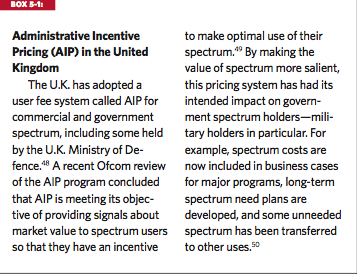
The UK has been in a leader in both creating a nationwide interoperable public safety systems and in creating incentives for government spectrum users to trade off efficient technology for less spectrum use.
National Broadband Plan: Preview
Here is the spectrum-related material:
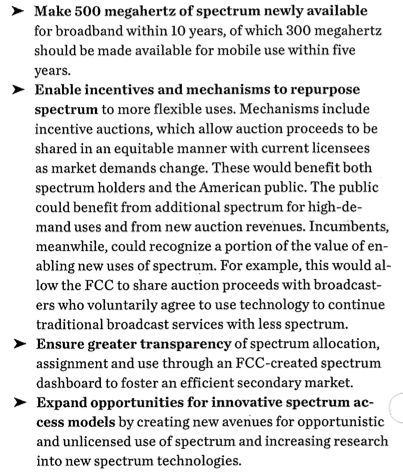
So I guess CTIA isn’t getting the 800 MHz they “demanded” - but did they ever really expect that much?
Letting broadcasters auction spectrum and keep some of the proceeds is an idea going back to OPP 38 in 2002 - a concept despised by the broadcast community, but a good idea nevertheless.
Opportunistic use and unlicensed spectrum are still in the running, but Docket 04-186 still seems to be on hold. Despite the adoption of rules, devices still can’t be sold pending further FCC action.

I clearly agree with this goal, but there needs to be a major improvement in FCC transparency and timeliness in resolving technical policy issues in spectrum. Note that Qualcomm was incorporated in July 1985 and was able to get the decision to permit the use of CDMA - a radical idea at the time - by 1988. FCC is no longer able to get anywhere close to this speed of decision making despite the 1 year mandate of Section 7 of the Communications Act.
FCC doesn’t have to approve all new technologies, but if it continually leaving them “twisting in the breeze” the financial community will lose all interest in financing bold new wireless technology companies like Qualcomm was 25 years ago.
“Mobile innovation” needs some major changes in FCC handling of new technologies and their regulatory issues.
UPDATE
The plan as released
A Tale of 2 Regulatory Commissions
While I worked at FCC, a colleague used to criticize me for comparing FCC to NRC. But I guess it is OK now that the ex parte NPRM actually compares the two agencies in that area. Hope you surf over to the PK blog and see what I wrote there.
The PK post also includes a suggestion I made on the reboot.FCC.gov site to require conferences that host key FCC speakers to provide the FCC website with videos of the presentations in a timely way. Feel free to go to that site and blast the idea as hopeless naive or even possibly support it.
Clearwire Helps 70/80 GHz Take Off!
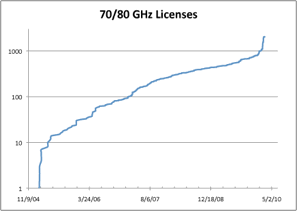
Thus it was gratifying to see public data on 70/80 GHz licenses, courtesy of Comsearch, Inc. one of the database managers, that when analyzed shows the above plot of licenses vs. date. Basically “Clearwire Spectrum Holdings II, LLC” submitted about 1000 registrations to Comsearch in February (at $75 each) for links apparently in support of their new WiMAX network.
This doubles the number of licenses essentially overnight!
AT&T Says 'No' to Texting While Driving

Wireless Week reports:
AT&T today announced a campaign aimed at curtailing the unsafe practice of texting while driving. The carrier hopes to raise awareness about the risks of texting and driving and remind all wireless consumers, especially youth, that text messages can, and should, wait until after driving.
Thus AT&T is breaking with the CTIA crowd and taking a more aggressive stand on the issue. CTIA’s position remains
The wireless industry is neutral on outright bans of cellular use while driving and hands-free legislation. We believe consumers can best determine what laws (bans or hands-free) that they would or would not support related to talking on their devices. At the same time, we believe text-messaging while driving is incompatible with safe driving, and we support state and local statutes that ban this activity while driving.
T-Mobile’s “driving tips” include nothing about texting. The only thing on the subject I could find on Sprint was a link to the horrific YouTube U.K. public service announcement shown below - a bloody example of what texting can result in. This PSA is so horrific that YouTube restricts to viewers over 18 - so it probably has limited impact on users. I could find nothing on VZW’s website on texting and driving.
However, if these firms provide me with links, I would be glad to revise this.
So congratulations to AT&T for making the decision to break from its more conservative competitors and push the safety issue here.
Shure Proves Marcus' First law of Spectrum

“Free spectrum is always cheaper than efficient wireless technology”
This has been proven in a self congratulatory press release on the “pitchengine.com” website: Shure, Inc. has announced that ”FCC received more than 300 letters, from houses of worship, theaters, education institutions, musicians, producers, sound engineers, AV rental and production companies, hotels, and convention centers during the comment period, which ended on March 1, 2010.”
Actually considering the ubiquity of these recently illegal products, 300 is a rather small number.
The release goes on to say
“Wireless microphone users are sending a strong and clear message that they and their audiences expect and deserve interference-free audio,” said Sandy LaMantia, President and CEO of Shure Incorporated. “Wireless microphones are an essential feature of professional sound production in many contexts where audio quality is a priority. These users need to be eligible for licenses that will afford them protection from interference from new devices using the same spectrum.”
Your blogger agrees. As has been said repeatedly here “"wireless mics are a legitimate use of spectrum (that) deserves more from FCC than benign neglect that allows most users only criminal spectrum squatting”.
But the key policy question is not whether there should be a legal path or wireless mic users, but rather is continued unlimited access to UHF “white space” spectrum an anachronism in the age of current spectrum policy and current wireless technology.
Any one who has observed the evolution of spectrum policy in the past 2 decades realizes that most private sector use of spectrum is subject to economic forces to assure spectrum gets to its highest and best use. There are exceptions for public safety and personal radio services, but not for the huge amount of “beach front” spectrum the wireless mic community seeks continued unfettered access to.
TV spectrum used to go to channel 84, then to channel 69, now it ends at channel 51. It is likely that the pending FCC Broadband Report will try to pack it down smaller. The number of TV stations hasn’t decreased so there is less white space, especially in urban markets. With analog TV, generally only 1 out of 6 channels was used in a given area due to limitation of TV sets - at least when the rules were set in 1953. (The TV broadcasters fought hard in the 1970s against having this reexamined in view of improved technology.)
The basic problem of long term use of UHF for wireless mics is benefit vs. opportunity cost. By the nature of their use, wireless mics using a negligible part of the space-time spectrum resource nationwide, yet they deny that resource to other users who could use it more intensively. While wireless mic spectrum use is intense in the Broadway area for a few hours a day, that is really a small fraction of the land area of the FCC’s jurisdiction.

Why don’t marketplace forces apply to wireless mics? In the UK, FCC’s counterpart, Ofcom has delegated wireless mic issues to a mandatory coordinator named JFMG which charges users for spectrum access and can use its income to procure spectrum. Why doesn’t FCC consider such a band manager for wireless mic use? Of course, the users prefer FREE SPECTRUM!
If wireless mics were used to another band with a more compatible sharing partner, they would not incur any opportunity cost. For example, wireless mics are short range links usually less than 100m and aeronautical telemetry ground stations are not located on Broadway, why can’t they share?

So why isn’t the CTIA crowd interested in providing a new service and a new income stream? They are all looking for “killer apps” like iPhone and don’t want to spend their limited R&D budget on niche markets with potential for only a few million here and there. Wake up CTIA: you covet the same UHF spectrum here yourself and the squandering of this resource on the present technology wireless mics is really a barrier to your own spectrum access. Addressing this market through minor modifications of present cellular products will both give you new income and help break the spectrum log jam!
In reality, wideband FM use of UHF spectrum is the only options for wireless mics for the next 2-4 years. It may be reasonable to let small wireless mic users with few units e.g. small churches and conference rooms, and noncritical use stay in the UHF band on a long term basis. But FCC could take a leadership role here in starting a transition to another technology and band for the large and professional wireless mic users who dominate the spectrum requirement. Broadcasters and Hollywood also may like the long standing deal for free spectrum use for their high income businesses, but that is also an anachronism in today’s policy environment.
Wi-Fi Takes the Rails

This morning Amtrak launched its Wi-Fi Internet service, known as AmtrakConnectSM aboard all 20 high-speed Acela Express trains, in six major stations along the Northeast Corridor, and in all four Club Acela lounges. Initially offered as a complimentary service, AmtrakConnect is available to every passenger on board Acela Express both in Business and First class seating.
“AmtrakConnect delivers the fast, reliable and consistent connectivity that our customers have been asking for,” said Matt Hardison, Chief, Sales Distribution and Customer Service, noting the on-board Wi-Fi system typically outperforms cellular air cards and smart phones.
Using any laptop computer or other portable device that is Wi-Fi enabled, Amtrak passengers traveling on Acela Express between Washington, D.C. and Boston can connect to the service for general Web surfing and reading email. The system also allows passengers to access their corporate networks through most standard Virtual Private Network (VPN) solutions, turning the train trip into productive work time.In addition, Amtrak is launching AmtrakConnect for all Amtrak passengers within the gate areas of Washington Union Station, Baltimore Penn Station, Philadelphia 30th Street Station, New York Penn Station, Providence Station and Route 128 Station in Boston. Wilmington Station will be Wi-Fi equipped once major station renovations are completed in early 2011. Wi- Fi service continues to be available in all ClubAcela lounges in Washington, DC, Philadelphia, New York, and Boston.
“This is only the first step for our AmtrakConnect program,” says Lenetta McCampbell, Senior Director for On-board Systems. “Amtrak will continually improve the service as Wi-Fitechnology evolves, and we are evaluating opportunities to expand AmtrakConnect to additional routes and stations throughout the country.” AmtrakConnect service on Acela Express trains will remain free of charge during theintroductory period, after which the policy will be reviewed based on customer demand and system performance.
AmtrakConnect was deployed on Acela Express by Virginia Beach-based GBS Group and its partner Nomad Digital.
FCC ex parte NPRM - Initial Thoughts
“I believe that transparency is best achieved through the creation and publication of clear rules. However, for the regulatory regime to be successful, these rules must also be strictly enforced. Based on personal experience, I know that the U.S. regulatory model has only been successful when the FCC has enforced its rules vigorously. Failure to enforce rules sends the inappropriate signal that companies may engage in anticompetitive behavior or other unlawful conduct with impunity.”
Let me provide for potential commenters some facts that are not in the NPRM.
1. In 2009, there were 6070 ex parte notifications filed at FCC. The numbers for 2008 and 2007 were 10,046 and 7,960 respectively. I assume that the drop in 2009 was due to both the inevitable drop in activity with major changes at the Commission and the distraction of the DTV transition.
2. I believe that the Commission’s ex parte rules were heavily influenced by Recommendation No. 77-3 of the former Administrative Conference of the U.S., formerly codified as 1 C.F.R. 305-77.3. The HBO Case mentioned in Chmn. Genachowski’s statement was in March 2007 and the ACUS recommendation was made in October of that year. The ACUS recommendation stated “Agencies should experiment in appropriate situations with procedures designed to disclose oral communications from outside the agency of significant information or argument respecting the merits of proposed rules, made to agency personnel participating in the decision on the proposed rule, by means of summaries promptly placed in the public file, meetings which the public may attend, or other techniques appropriate to their circumstances.”
3.While the NPRM mentions ex parte policies at 3 other commissions, it fails to mention the key fact that parallel policies are in place at all regulatory agencies, be they independent agencies like FCC or Executive Branch agencies. But only FCC has the system where the outside party files the summary that goes on the public record. Thus in the 30 odd years that ex parte procedures have been used for agency rulemaking, no other agency has ever adopted the FCC’s approach. Perhaps the Commission should ask why?
4.Finally, the NPRM states in para. 32 “Regardless of what amendments are adopted in this proceeding or when, we intend to place greater emphasis on enforcement against impermissible ex parte contacts.” This implies there has been some previous emphasis on enforcement. A fairer statement is that enforcement has been ignored for decades. At the October public workshop the staff stated that it dealt with complaints by calling the party at issue and telling them not to do it again. This is reminiscent of the comedy skit in which an unarmed British policemen says to a fleeing robber “Stop or I’ll say stop again”. As far as I can tell, the Commission has NEVER taken ANY ex parte enforcement action. While the NPRM mentions the possibility of “monetary forfeitures”, I doubt that it has legal authority to do so. However, it does have the authority - unused to date - to forbid future oral ex parte by the guilty party and that should be more than adequate IF there is ANY interest in enforcing these rules.
UPDATE
Your blogger’s Petition for Review has finally made it to circulation on the 8th Floor more than a year after it was filed. This was not a very complex matter although it may be the first time ever the commissioners had to formally consider enforcement of their rules.
Stay tuned for the outcome. How much longer could it take?
Ex Parte Reform Proposal at FCC
Oddly, MSTV has nothing on their website yet on the topic.
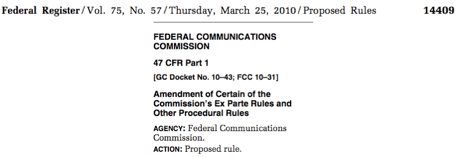



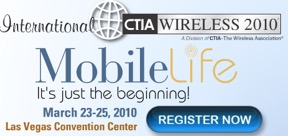


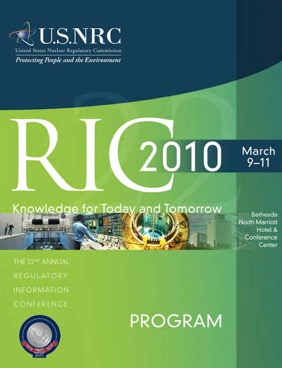



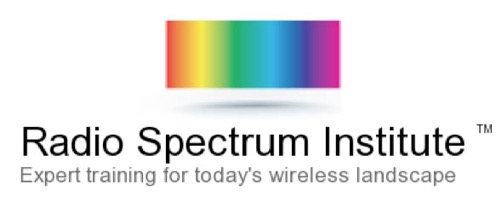


![Validate my RSS feed [Valid RSS]](valid-rss-rogers.png)

